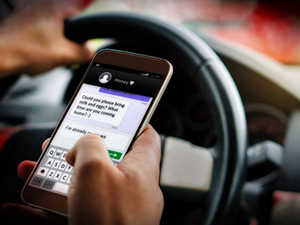By Tom Wolff
 In this session, Adam Wilberding led an informative and moving discussion on the dangers of distracted driving, whether it be texting, talking on the phone or manipulating the dashboard. Cognitive distraction or mental distraction, occurs when a driver is focusing on something other than the task at hand: driving. The speaker emphasized that contrary to popular belief, the brain is not capable of multitasking. The brain switches, often rapidly, between two cognitive activities. While driving, the brain’s top priority is looking as opposed to listening, and therefore drivers can fail to see up to 50% of the information in their driving environment. The speaker also emphasized that there is a popular misconception about hands-free driving: that it is safe. Hands-free driving is NOT safer than driving with a phone in the hand. This is because the driver with a hands-free device is still very distracted by engaging in a conversation with another person or involved with voice-to-text. Any type of speech production causes distraction because the driver focuses on the conversation instead of driving and the driving environment.
In this session, Adam Wilberding led an informative and moving discussion on the dangers of distracted driving, whether it be texting, talking on the phone or manipulating the dashboard. Cognitive distraction or mental distraction, occurs when a driver is focusing on something other than the task at hand: driving. The speaker emphasized that contrary to popular belief, the brain is not capable of multitasking. The brain switches, often rapidly, between two cognitive activities. While driving, the brain’s top priority is looking as opposed to listening, and therefore drivers can fail to see up to 50% of the information in their driving environment. The speaker also emphasized that there is a popular misconception about hands-free driving: that it is safe. Hands-free driving is NOT safer than driving with a phone in the hand. This is because the driver with a hands-free device is still very distracted by engaging in a conversation with another person or involved with voice-to-text. Any type of speech production causes distraction because the driver focuses on the conversation instead of driving and the driving environment.
Mental distractions can last up to 27 seconds, which is plenty of time for serious accidents to occur. In addition to the loss of life or physical and mental incapacities resulting from accidents, significant settlements and jury verdicts will result. In order to try and avoid civil lawsuits, some companies such as Owens-Corning and Cummins have completely banned cell phone use. They have found no loss in productivity as a result. The National Safety Council has a safe driving kit to assist employers in developing safe driving policies. The session ended with two very compelling documentary videos of people who have experienced death or severely debilitating injuries because another driver was texting just before that person caused a serious accident.

